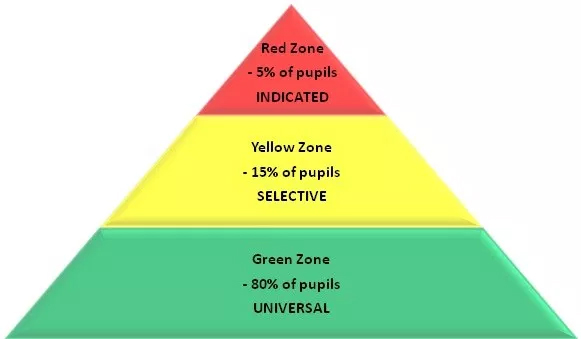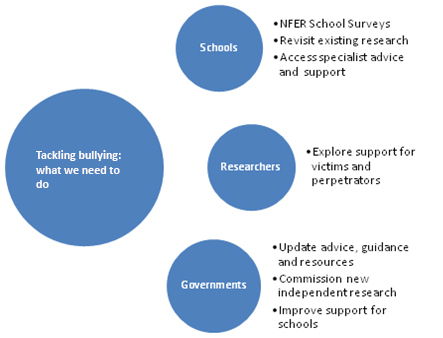Bullying: what’s new?
Wednesday 18 November 2015
Since my last blog post in June, bullying has been very much on the radar through the publication of new research, the launch of a new anti-bullying initiative, and the release of updated guidance for schools and parents from the Welsh and UK Governments. I’ve produced this update to coincide with Anti-Bullying Week 2015, to refocus attention on this important topic through outlining these important developments and exploring the next steps in tackling bullying.
So where were we?
New research review
When I last wrote about bullying, I emphasised the need for action to help headteachers understand the nature and extent of bullying in their schools, and to empower them to take effective action against it.
New research published to mark the anniversary of forty years of research on school bullying recommends that schools adopt a three-tiered approach (summarised in the diagram below) to tackle bullying. This approach comprises: universal support activities involving all pupils, staff and settings; selective activities such as group intervention and support for 10-15 per cent of pupils who are displaying ‘risky’ behaviours; and indicative activities involving 5 per cent of pupils who have been victims or perpetrators of bullying.
The Three-Tiered Framework of Positive Behavioural Interventions and Support (PBIS) (adapted from Bradshaw, 2015)

This useful model clarifies the levels of support that schools should consider implementing to ensure that all pupils receive the right support to minimise the harmful legacy left by bullying.
The research also emphasises the need for schools to regularly and systematically collect data on bullying through anonymous surveys, to inform their approaches to bullying prevention, and to identify staff training needs in order to tackle bullying more effectively.
In my earlier post, I highlighted Estyn’s research, which suggests that schools inconsistently record and deal with bullying. The new research offers a fresh explanation for this finding, claiming that some schools do not routinely collect data on bullying and the effectiveness of their anti-bullying approaches as they perceive it to be costly and burdensome.
This is where NFER’s School Surveys can really help. Our Safety & Bullying themed survey for pupils include questions about safety in the local area, incidences of bullying in school, and how the school deals with bullying. Alternatively, schools can produce their own surveys. The main benefit of using the NFER surveys is a comparison with national data to help with improvement planning. For example, the national data for primary schools shows that 24% of pupils say “In the past year I have been picked on or bullied at school”. An understanding of the national picture helps to put responses in perspective.
A new anti-bullying programme
Excitingly, a new anti-bullying programme has been launched by ENABLE (European Network Against Bullying in Learning and Leisure Environments) – a holistic, skills-based approach that incorporates methodologies that have been successful in previous programmes. ENABLE embodies the Social and Emotional Learning (SEL) approach. It features in-built ‘real time’ assessment and implementation elements, and is adaptable for use across different countries’ curricula. This promising new programme represents an important addition to the suite of tools available to empower schools to tackle bullying – partly addressing another of my recommendations. Of course, programme effectiveness can only be truly demonstrated through rigorous, independent evaluation – food for thought for programme designers.
Updated guidance
I previously emphasised the need for governments to update their advice, guidance and resources for schools. Encouragingly, the Welsh and UK Governments have made a start on this. The Welsh Government published new e-safety resources to coincide with Safer Internet Day 2015, including: web filtering guidance for schools, support for teachers to teach safe, responsible and considerate online behaviours; and guidance for parents on cyberbullying. In addition, the UK Government has produced updated guidance for reporting bullying in and out of school.
And where are we now?
All of the developments I have highlighted show that tackling bullying remains high on policy, practice and research agendas. The challenge facing schools now is to evaluate and reflect on their approaches to this issue (supported by regularly and systematically collected data), and to put in place effective evidence-based interventions that support and protect all pupils from the harmful effects of bullying.

